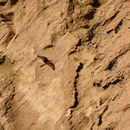Prairie falcons occupy open treeless terrain including prairies,
deserts, riverine escarpments, canyons, foothills, and mountains in
relatively arid western regions [
13,
16,
32,
34]. In the Sierra Nevada
prairie falcons range above timberline in late summer but winter at
lower elevations [
34].
Nesting habitat - During the breeding season prairie falcons are
commonly found in foothills and mountains which provide cliffs and
escarpments suitable for nest sites [
16]. Occasionally prairie falcons
nest at altitudes of 10,000 feet (3,048 m), although this is
exceptional. The highest recorded nest site is 11,699 feet (3,566 m) in
Colorado [
32]. Prairie falcons generally nest on cliffs, from low rock
outcrops of 30 feet (9 m) to vertical cliffs 400 feet (121 m) high.
They prefer cliffs with a sheltered ledge with loose debris or gravel
for a nest, overlooking treeless country for hunting. They may also
nest in potholes or large caves [
32]. Prairie falcons sometimes use old
nests of ravens (Corvus spp.), hawks, and golden eagles (Aquila
chrysaetos) [
8,
13,
32]. Nest sites with southern or eastern exposures
are preferred. However, in southwestern Idaho no preference was noted
[
16], and in the San Joaquin Valley, California, most prairie falcon
nests had northern exposures and no south-facing ledges were used [
32].
Prairie falcons usually have alternate nesting sites located on the same
cliff and tend to use alternate ledges in succeeding years. Nesting
failure does not seem to deter use of the cliff in the following year
[
32].
Of 36 nesting cliffs in Colorado and Wyoming, 14 were sandstone, 10 were
sedimentary conglomerate, 7 were limestone, and 5 were granite.
Twenty-two nesting ledges faced south, five faced north and nine faced
east or west [
32]. In southeastern Montana and northern Wyoming,
Phillips and others [
28] reported that all prairie falcon nests were
found in cracks or potholes in sandstone cliffs. The mean distance
between occupied nest sites was 4.8 miles (7.8 km) [
28].
In British Columbia prairie falcon nests were situated on ledges, in
caves, in crevices, and in potholes on cliffs. Nesting cliffs were
granite or sandstone and ranged from 49 to 453 feet (15-138 m) in
height; the actual nest site ranged from 29 to 295 feet (9-90 m) from
the base of the cliff [
12].
Foraging habitat - Prairie falcons generally forage in open areas with
low vegetation containing ground squirrels (Spermophilus spp.) and
passerine birds. They tend to have definite hunting ranges. When food
is plentiful these areas are confined to the least possible radius
necessary to secure required food supplies [
32], but prairie falcons
will forage up to 15 miles (24 km) from the nest [
21]. The usual
hunting method consists of flying at a altitude of 50 to 300 feet (15-91
m) and diving at potential prey. Prairie falcons also hunt from
perches. Prairie falcons often eat while perched on a convenient
vantage point or on the ground where they have captured their prey [
32].
During the breeding season extra food is cached near the nest for
subsequent use [
16].
Winter habitat - Winter habitat for prairie falcons is generally the
same as nesting habitat, except that high elevation areas are not used
[
27]. In northern Colorado winter ranges (maximum distance between
observation points of individual marked birds) averaged 3.8 miles (6.1
km) for males and 7.2 miles (11.5 km) for females. The maximum range
was 12.1 miles (919.4 km) for one female [
34].

